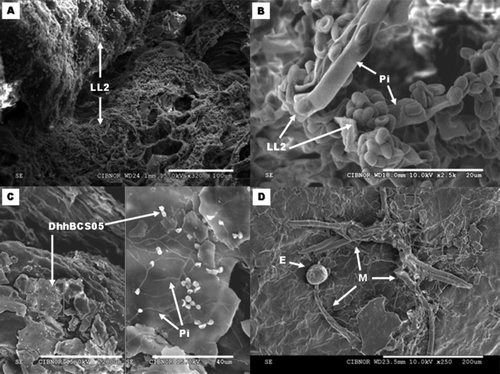Figures & data
Figure 1. Fruit rot caused by Penicillium italicum (Pi) on Mexican lime and inoculated with different strains of Debaryomyces hansenii. (A) Inoculated only with Pi. (B) Pi and DhhBCS05. (C) Pi and DhhBCS06. (D) Pi and LL02. The fungal pathogen was adjusted to 104 spores mL–1 and the yeasts were adjusted to 108 cells mL–1. Fruit were stored for three weeks at 25°C and 80% RH.
Figura 1. Pudrición ocasionada por Penicillium italicum (Pi) sobre limón mexicano inoculado con diferentes cepas de Debaryomyces hansenii. (A) frutos inoculados con el fitopatógeno. (B) Pi más DhhBCS05. (C) Pi más DhhBCS06. (D) Pi más LL02. La concentración del hongo fue ajustada a 104 esporas mL–1 y de las levaduras a 108 células mL–1. Los frutos fueron almacenados durante tres semanas a 25°C y 80% de HR.
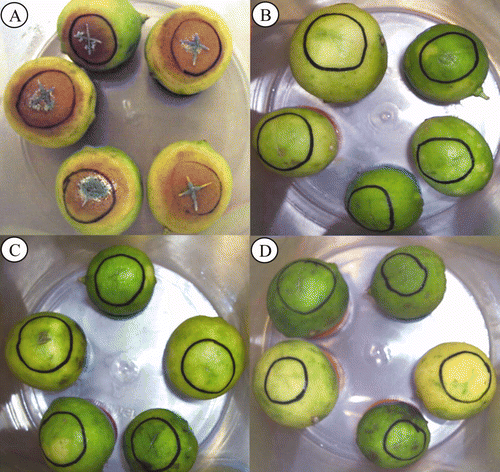
Figure 2. Incidence of Penicillium italicum in Mexican lime fruit inoculated with three concentrations of antagonistic yeasts. Strains of Debaryomyces hansenii used were: DhhBCS03, DhhBCS05, DhhBCS06, LL01, LL02, and P. guilliermondii NRRL-Y-50426. The fungicide imazalil (IMZ) was applied at 250 ppm. Fruit were stored at 25°C and 80% RH for 21 days. Columns with the same letter are not significantly different (LSD, P < 0.05).
Figura 2. Incidencia de la pudrición ocasionada por Penicillium italicum en limón mexicano inoculado con tres dosis de levaduras antagónicas. Las cepas utilizadas de Debaryomyces hansenii fueron DhhBCS03, DhhBCS05, DhhBCS06, LL01, LL02, y de P. guilliermondii NRRL-Y-50426. El fungicida imazalil (IMZ) fue aplicado a 250 ppm. Los frutos fueron almacenados a 25°C y 80% de HR durante 21 días. Columnas con la misma letra no son significativamente diferentes (LSD, P < 0,05).

Figure 3. Lesions caused by Penicillium italicum in Mexican lime fruit inoculated with three concentrations of antagonistic yeasts. Strains of D. hansenii used were: DhhBCS03, DhhBCS05, DhhBCS06, LL01, LL02, and P. guilliermondii NRRL-Y-50426. The fungicide imazalil (IMZ) was applied at 250 ppm. Fruit were stored at 25°C and 80% RH for 21 days. Columns with the same letter are not significantly different (LSD, P < 0.05).
Figura 3. Tamaño de lesión ocasionado por Penicillium italicum en limón mexicano inoculado con tres dosis de levaduras antagónicas. Las cepas utilizadas de Debarymoyces hansenii fueron DhhBCS03, DhhBCS05, DhhBCS06, LL01, LL02, y de P. guilliermondii NRRL-Y-50426. El fungicida imazalil (IMZ) fue aplicado a 250 ppm. Los frutos fueron almacenados a 25°C y 80% de HR durante 21 días. Columnas con la misma letra no son significativamente diferentes (LSD, P < 0,05).
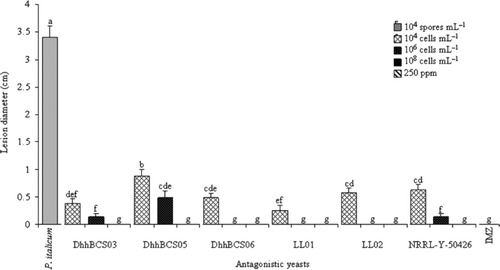
Figure 4. Incidence of Penicillium italicum in Mexican lime fruit inoculated with three concentrations of antagonistic yeasts. Strains of Debaryomyces hansenii used were: DhhBCS03, DhhBCS05, DhhBCS06, LL01, LL02, and P. guilliermondii NRRL-Y-50426. The fungicide imazalil (IMZ) was applied at 250 ppm. Fruit were stored at 13°C and 90% RH for 21 days. Columns with the same letter are not significantly different (LSD, P < 0.05).
Figura 4. Incidencia de la pudrición ocasionada por Penicillium italicum en limón mexicano inoculado con tres dosis de levaduras antagonistas. Las cepas utilizadas de Debaryomyces hansenii fueron: DhhBCS03, DhhBCS05, DhhBCS06, LL01, LL02, y P. guilliermondii NRRL-Y-50426. El fungicida imazalil (IMZ) fue aplicado a 250 ppm. Los frutos fueron almacenados a 13°C y 90% de HR durante 21 días. Columnas con la misma letra no son significativamente diferentes (LSD, P < 0,05).
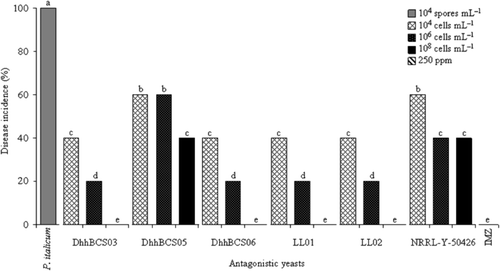
Figure 5. Lesions caused by Penicillium italicum in Mexican lime fruit inoculated with three concentrations of antagonistic yeasts. Strains of D. hansenii used were: DhhBCS03, DhhBCS05, DhhBCS06, LL01, LL02, and P. guilliermondii NRRL-Y-50426. The fungicide imazalil (IMZ) was applied at 250 ppm. Fruit were stored at 13°C and 90% RH for 21 days. Columns with the same letter are not significantly different (LSD, P < 0.05).
Figura 5. Tamaño de lesión ocasionado por Penicillium italicum en limón mexicano inoculado con tres dosis de levaduras antagónicas. Las cepas utilizadas de Debarymoyces hansenii fueron DhhBCS03, DhhBCS05, DhhBCS06, LL01, LL02, y de P. guilliermondii NRRL-Y-50426. El fungicida imazalil (IMZ) fue aplicado a 250 ppm. Los frutos fueron almacenados a 13°C y 90% de HR durante 21 días. Columnas con la misma letra no son significativamente diferentes (LSD, P < 0,05).
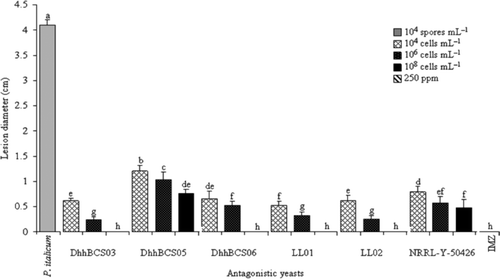
Figure 6. Microphotographs of the interaction between strains of Debaryomyces hansenii and Penicillium italicum in wounds of Mexican lime. (A) Fruit wound inoculated with the strain LL2 at a concentration of 108 cells mL–1 after 21 days in storage. (B) Parasitism of LL02 yeast and mycelium of P. italicum (Pi). (C) Interaction between strain DhhBCS05 and Penicillium italicum (Pi) in inoculated wounds of Mexican lime at a concentration of 108 cells mL–1 and 104 spores mL–1, respectively. (D) Spore E and mycelium M of Penicillium italicum penetrating wounds on the surface of the lime. Samples were taken from fruit stored for 21 days at 13°C and 90% RH.
Figura 6. Micrografías de la interacción entre cepas de Debaryomyces hansenii y Penicillium italicum en heridas de limón mexicano. (A) Herida del fruto inoculado con la cepa LL02 a una concentración de 108 células mL–1 después de 21 días de almacenamiento. (B) Parasitismo de la levadura LL02 en el micelio de P. italicum (Pi). (C) Interacción entre la cepa DhhBCS05 y Penicillium italicum (Pi) dentro de la herida del limón mexicano inoculada a una concentración de 108 células mL–1 y 104 esporas mL–1 respectivamente. (D) Espora E y micelio M de Penicillium italicum penetrando en las heridas del limón mexicano. Las muestras fueron tomadas de frutos almacenados por 21 días a 13°C y 90% de HR.
